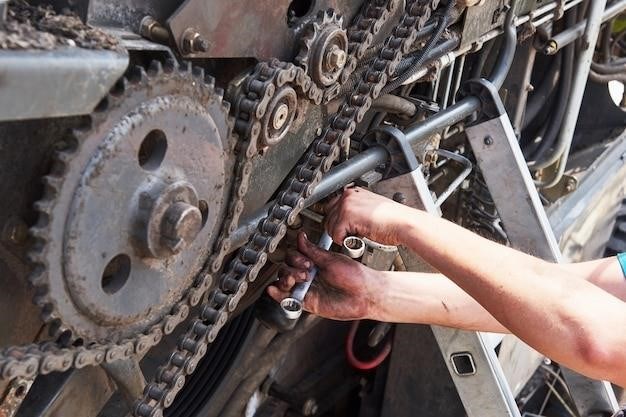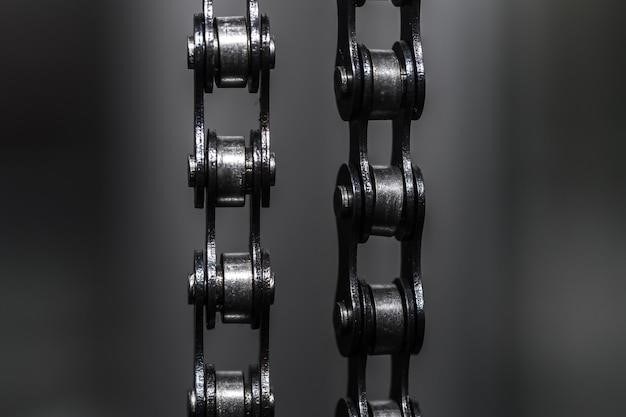Roller Chain Size Guide⁚ A Comprehensive Overview
This guide provides a complete overview of roller chain sizing, covering ANSI standards, measurement techniques, and selection criteria for various applications. Explore single and multi-strand chains, heavy-duty options, and metric equivalents to find the perfect fit for your needs. Detailed charts and resources simplify the selection process.
Understanding Roller Chain Sizes
Roller chains are categorized primarily by their pitch, which is the distance between the centers of two consecutive rollers. This fundamental dimension dictates the chain’s strength and suitability for specific applications. Smaller pitch chains are ideal for lighter loads and higher speeds, while larger pitch chains handle heavier loads and lower speeds. The pitch is often expressed in eighths of an inch for ANSI standard chains (e.g., a #40 chain has a 1/2-inch pitch), providing a quick reference for size comparison. However, the actual dimensions of a roller chain go beyond just the pitch; other critical measurements include roller diameter, inner width, plate height, and plate thickness. These dimensions influence the chain’s overall strength, durability, and compatibility with sprockets. Understanding these parameters is key to selecting the correct chain for your machinery.
Furthermore, the number of strands significantly affects load capacity. Single-strand chains are suitable for many applications but may not be sufficient for heavy-duty work. Multi-strand chains, comprising two or more strands running in parallel, substantially increase the load-bearing capacity. The material composition also plays a role; high-quality carbon steel is prevalent, but specialized materials might be needed for extreme conditions. Therefore, a thorough understanding of all these factors ensures optimal performance and longevity.
ANSI Roller Chain Sizes and Standards
The American National Standards Institute (ANSI) establishes standardized sizes for roller chains, ensuring interchangeability and simplifying selection. These standards define key dimensions like pitch, roller diameter, and width for various chain sizes, typically numbered from 25 to 240. Each number represents a specific pitch, with higher numbers indicating larger pitches and consequently, greater load-carrying capacities. For example, a #40 chain has a 1/2-inch pitch, while a #80 chain has a 1-inch pitch. ANSI standards also specify tolerances for these dimensions, guaranteeing consistent quality and performance across different manufacturers; This standardization facilitates easy replacement and simplifies the design process for engineers and technicians.
Beyond the basic dimensions, ANSI standards also address other crucial aspects, including tensile strength, which is a measure of the chain’s ability to withstand pulling forces. These standards ensure that chains of a given size meet minimum strength requirements, providing a reliable basis for selecting the appropriate chain for a particular application. Adherence to ANSI standards is crucial for ensuring compatibility between chains and sprockets from different manufacturers, preventing potential malfunctions and ensuring smooth operation of machinery. The detailed specifications provided in ANSI standards contribute significantly to the reliability and safety of numerous industrial applications.

Measuring Roller Chain⁚ A Step-by-Step Guide
Accurately measuring roller chain is crucial for selecting the correct replacement or determining existing chain specifications. Begin by identifying the chain’s type (single, double, triple strand, etc.). A printable chain template can aid in recording measurements. The most critical measurement is the pitch (P), the distance between the centers of two consecutive rollers. Use a ruler or caliper to measure this precisely. Next, measure the roller diameter (d1), the diameter of a single roller. Also, measure the inner width (b1), the distance between the inner sides of the link plates. These three dimensions (P, d1, b1) are key for identifying the chain size. You may also want to record the roller width (W), overall width (A), plate height (H), plate thickness (T), and pin diameter (E) for more comprehensive data.
After recording these measurements, carefully compare them to a roller chain size chart. Pay close attention to tolerances specified in the chart, as slight variations may occur due to manufacturing processes. Match your measurements to the chart’s values to identify the chain size. If discrepancies exist between your measurements and the chart, re-measure to ensure accuracy. If uncertainties remain, consult a chain supplier or specialist for assistance. Accurate measurement is essential for selecting a properly fitting replacement chain, ensuring optimal performance and longevity of the equipment.
Interpreting Roller Chain Dimensions
Understanding roller chain dimensions is vital for proper selection and application. Key dimensions include pitch (P), the center-to-center distance between adjacent rollers, which determines the chain’s overall size and strength. Roller diameter (d1) affects the chain’s load-carrying capacity and smoothness of operation. Larger diameters generally handle heavier loads. Inner width (b1), the distance between the inner link plates, influences the chain’s ability to fit onto sprockets and guide rails. Precise measurements are crucial for compatibility.
Other important dimensions include roller width (W), affecting chain durability and wear resistance; overall width (A), which dictates space requirements for installation; plate height (H) and thickness (T), impacting chain strength and stiffness; and pin diameter (E), affecting the chain’s tensile strength. These dimensions, often presented in charts, are crucial for selecting a chain appropriate for a specific load, speed, and application. Consult manufacturer’s specifications for precise tolerance ranges. Understanding these dimensional relationships allows for appropriate chain selection, preventing failures and ensuring optimal equipment performance. Incorrect interpretation can lead to chain malfunction or premature failure.
Single Strand vs. Multi-Strand Roller Chains
The choice between single and multi-strand roller chains hinges on the application’s load requirements and desired operational characteristics. Single-strand chains, the simplest configuration, consist of a single row of rollers and are suitable for lighter-duty applications where lower cost and simpler design are prioritized. They are commonly used in conveying systems, smaller machinery, and applications with moderate power transmission needs. Their simplicity makes them easy to install and maintain.
Conversely, multi-strand chains, featuring multiple rows of rollers, are designed for heavier loads and higher power transmission demands. Double, triple, and even quadruple strand configurations are available, each offering increased load capacity and durability. The increased number of rollers distributes the load more effectively, enhancing the chain’s longevity and minimizing wear. Multi-strand chains are ideal for industrial machinery, heavy-duty conveyors, and applications demanding high strength and reliability. The selection depends on the specific load, speed, and operating conditions of the equipment. While multi-strand chains offer superior strength, they are more expensive and complex to install and maintain.

Heavy-Duty and Specialty Roller Chains
Beyond standard single and multi-strand chains, heavy-duty and specialty roller chains cater to demanding applications requiring exceptional strength, durability, and resistance to harsh environments. Heavy-duty chains are engineered with robust components, including thicker plates, larger rollers, and stronger pins, enabling them to withstand significantly higher loads and stresses than standard chains. These are frequently employed in demanding industrial settings, such as mining, construction, and heavy manufacturing, where reliability is paramount. Their increased strength comes at a cost, however, with higher purchase prices and potentially increased maintenance needs.
Specialty roller chains are designed for specific applications or environmental conditions. These might include chains with corrosion-resistant coatings for use in wet or chemically aggressive environments, self-lubricating chains for extended operational life and reduced maintenance, or chains with unique configurations to accommodate specific sprocket designs or operating parameters. Examples include chains designed for high-temperature operation, those with enhanced wear resistance, or chains incorporating features like sealed rollers to prevent lubricant leakage. Selecting a specialty chain requires careful consideration of the application’s specific demands and environmental factors.
Metric Roller Chain Size Chart
Metric roller chains, unlike their ANSI counterparts, utilize a metric system for dimensional specifications. A metric roller chain size chart typically lists key dimensions such as pitch (distance between roller centers), roller diameter, inner width (distance between link plates), and other critical parameters in millimeters. These charts are essential for selecting the appropriate chain for applications where metric components are prevalent, particularly in European or other international markets. The organization of a metric chain size chart usually follows a numerical or alphanumeric system based on the chain’s pitch and number of strands;
Unlike ANSI charts where the number often indicates the pitch in eighths of an inch, metric charts use a direct numerical system for easier identification. For example, a “10B” chain designation might indicate a specific pitch and configuration. The charts will clearly present dimensions for single, double, and triple strand chains, each with its unique set of measurements. Accurately measuring your existing chain using calipers or a suitable measuring tool is crucial before consulting a metric roller chain size chart. Ensure accurate measurements of pitch, roller diameter, and inner width for precise chain selection. This prevents compatibility issues with sprockets and ensures proper function within the intended application.
Selecting the Right Roller Chain for Your Application
Choosing the correct roller chain hinges on several critical factors. First, accurately determine the load requirements of your application. This includes the weight being conveyed or the power being transmitted. Underestimating the load could lead to premature chain failure, while overestimating might result in unnecessary expense. Next, consider the operating speed. High-speed applications demand chains designed to withstand the increased stresses, often featuring specialized materials or construction. Similarly, the environment plays a role; corrosive environments call for corrosion-resistant chains, while high-temperature applications need chains capable of withstanding elevated temperatures without significant degradation.
The desired chain length is also crucial. Accurate calculation or measurement of the required length is essential to ensure proper function and prevent premature wear. Chain length is directly related to the number of links, which must be carefully determined based on the application’s geometry and sprocket sizes. Finally, consult a roller chain size chart to match the calculated requirements with available chain sizes and configurations. Consider factors like single versus multi-strand chains, material specifications (carbon steel, stainless steel, etc.), and any special features (such as cotter pins) needed for your specific application. Remember, careful selection ensures optimal performance, longevity, and safety.
Resources and Further Information
For detailed technical specifications and comprehensive chain selection guides, consult the resources provided by major roller chain manufacturers. Their websites often feature downloadable catalogs, detailed dimensional charts, and application guides covering various chain types and sizes. These resources typically include information on ANSI standards, metric equivalents, and specialized chain configurations for heavy-duty applications or specific environmental conditions. Many manufacturers also offer online tools and calculators to simplify chain selection based on your application’s specific parameters.
In addition to manufacturer resources, various industry publications and engineering handbooks provide valuable information on roller chain design, selection, and maintenance. These resources often delve into the theoretical aspects of chain mechanics, offering a deeper understanding of the factors influencing chain performance and longevity. Furthermore, online forums and communities dedicated to engineering and industrial applications can provide practical advice and troubleshooting assistance from experienced professionals. Remember to always cross-reference information from multiple sources to ensure accuracy and to address any discrepancies in the data you find.
